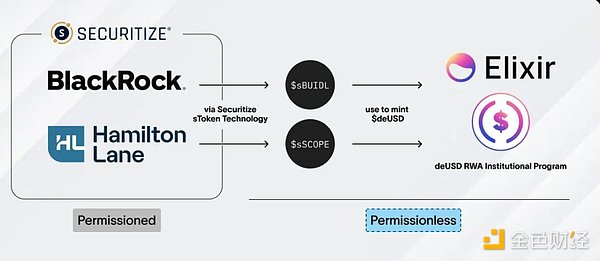
Author: DeFi Cheetah Source: X, @DeFi_Cheetah Translation: Shan Oppa, Golden Finance
In 1 CRV rose from $0.2 to $1.1 within a month. What happened? Curve Finance is shaping up to be the primary gateway for institutional money into DeFi, and $crvUSD could expand exponentially due to huge institutional capital inflows.
Problem backgroundBlackRock launched $BUIDL (tokenized US treasury, tokenized US Treasury bond fund). However, due to regulatory requirements, $BUIDL holders can only Transfer tokens to other pre-approved investors. This means that $BUIDL transactions are completely isolated from the DeFi ecosystem.
Through the Elixir platform, $BUIDL holders can mint $deUSD by staking $BUIDL (i.e. $sBUIDL). Crucially, similar to $USDe, Elixir has chosen Curve Finance as the primary liquidity hub for $deUSD. This choice had far-reaching consequences.
Potential impact: Institutional capital enters DeFi
Currently, the asset size of $BUIDL reaches US$551 million, and it is expected that this will be the first batch of institutional capital to enter DeFi. As this trend expands, more tokenized U.S. Treasury bonds may also flow into DeFi, and there is a high probability that these funds will be realized through Curve Finance.
The inflow of institutional capital is of great significance to $crvUSD's business:
•Funds inflow It is likely that $crvUSD will be purchased and staked to enjoy an annualized yield of approximately 15%.
•This yield comes from interest income on $crvUSD, creating a self-reinforcing flywheel effect.
The influence of flywheel effectThis interest income comes from the demand for leverage in the bull market. For example, on the DeFi Saver platform, users can use $crvUSD to loop against $BTC, $ETH or other collateral.
Once institutions holding $BUIDL or other tokenized Treasury securities mint $deUSD or other stablecoins on the Curve platform, they can easily spend those funds on purchases $crvUSD And stake to obtain high returns without lock-in.
Many people may worry that as the number of participants increases, the rate of return will decrease significantly. But in fact, Flywheel. The effect comes into play here:
• As more people buy and stake $crvUSD, the price of $crvUSD will be higher than $1
•Pegkeeper will cast more $crvUSD, increasing Pegkeeper debt, lowering interest rates
• In a bull market, huge borrowing demand will drive the price of $crvUSD below $1 again, thus increasing collateral. This self-reinforcing flywheel mechanism can help $crvUSD. Achieve exponential expansion. The dynamic adjustment of its interest rate mechanism ensures that it is always attractive in market changes.
Currently, the main bottleneck of $crvUSD is not the lack of borrowing demand, but the lack of buying pressure or actual use cases, which cannot effectively digest the selling pressure caused by loop operations or leveraged transactions. If $crvUSD is lower than $1 for a long time, Its high interest rates will deter other potential players.
BlackRock. Opportunities with ElixirBlackRock's $BUIDL and Elixir provide a bright future for $crvUSD's flywheel effect:
•Institutional investors earn considerable profits from the interest income of $crvUSD;
•The increasing demand for institutional income has promoted the large-scale development of $crvUSD.
This is a win-win situation, marking the deep integration of DeFi and traditional finance possibility. With the continued inflow of institutional capital, the value of $CRV may further increase. If the flywheel effect of $crvUSD can be fully unleashed, its scaling potential will be difficult to estimate.














